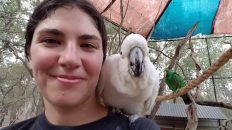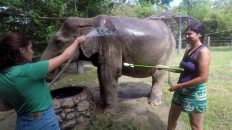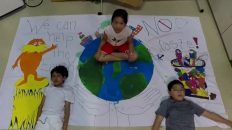Since April, I have been working and teaching a thematic unit titled “The Environment.” A thematic unit is where a teacher focuses on a theme, and then uses various books and activities to put together lessons related to a topic. This way, the students can dive into a subject, rather than skim it. For example, when I did our community thematic unit, we read books about community helpers and signs, identified the uniforms and tools community helpers use, and looked at the shapes and letters in community signs, etc.
In this environment unit, we celebrated animal holidays, read books about helping the environment, and reflected on our own actions and identified what we could do better to help the Earth. Since this is a special needs classroom, a lot of the discussion was teacher-lead, but that doesn’t mean that my students were unable to participate or change their actions. One of my favorite ways my students reduced waste in their own life was by using less water – when washing hands, brushing teeth, and washing dishes. Through my video modeling study, I was able to let my students see and experience firsthand what it looked and sounded like to reduce water when doing these actions. We reflected on videos of me and the students and discussed what they needed to do. Another way we incorporated this was in making magic muffins (which is a super yummy treat); I was able to incorporate reducing water, soap, and paper towel waste and assess student’s ability to wash their hands.
Do all of them reduce their water/soap/paper towel waste? No. Do some of them still need reminders? Yes, but wouldn’t you need a reminder or two when changing a habit that you’ve done for your whole life?
The video above is an end project music video, to the tune of Justin Beiber’s “Sorry” but this version is titled “Sorry Earth.” I did a version of this the 2015-2016 school year with my classroom for our environment unit project – it was inspired by our classroom love of the Lorax and the song “Sorry” (they would request to play it on repeat.) So in combining their love of the planet and pop songs, this year we partnered with a classroom from our high school wing to create this new version. We met every Friday for our Random Acts of Kindness curriculum, and practiced the song, discussed how to help the Earth, cleaned up our school grounds, and pretended to be the Lorax while running through bubbles.
This environment curriculum will be expanded while on my adventure around the world using this video blog, but I will share some books, my reviews, and lessons that I did during this unit. Please feel free to use any of my videos on my YouTube channel, as well as lessons on this site, so you can help create a planet that works and benefits all living things.
- I focused on using yes/no questions throughout this entire unit, so my students can answer using tech devices and be more active in the lesson. Our literacy goals were based around vocabulary words, such as the 5 R’s (refuse, reduce, reuse, rot, recycle) and identifying the main character in the story and what they stood for (the trees).
- I would have definitely created more visuals and vocabulary cards for future lessons in this unit, and expanded the theme and incorporated more activities in small groups. It was difficult to do this, however, because my students were being tested in DLM from April 19 to May 21st, and then Brigance testing immediately after this, so I was not able to lead any small groups because I was individually testing my students for over a month.
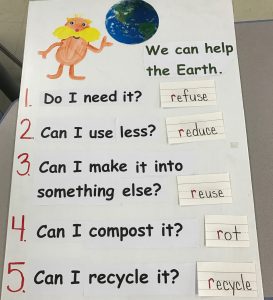 The Lorax by Dr. Seuss
The Lorax by Dr. Seuss
- We obviously had to start this unit with the inspiration of the main character who speaks for the trees, the Lorax! My students quickly became familiar with this character if they weren’t already. This book needed paraphrasing, and we broke the book in my classroom into beginning, middle, and end. I would read the beginning of the story to them for a week, and we would discuss how they feel when they see a tree, and whether it is a good choice to chop down a tree (obviously, the answer is no). In the middle, where the Onceler just kept polluting and polluting, I would ask using yes or no questions whether they think he would stop, and what they predicted the Lorax was going to say next. In the end, we related the Lorax back to our actions, and talked about planting seeds.
- When introducing this Unit, I was starting a BluePrint Curriculum Unit based on the theme of “Seeds, Plants, and Gardens.” We discussed what plants needed in order to survive, learned a dance to the Needs of a Plant song, and practiced and learned about composting.
How to Help the Earth, by the Lorax
- This book is a Random House “Step into Reading” book that was a much easier and engaging read for my students than the Lorax. The character is the Lorax, so we have two different books with the same main character, so we were able to use funds of knowledge to know that the Lorax says “Stop! I speak for the trees.” In this book, we added “and the fish, and the birds, and I’m asking you please to help the Earth.”
- In this book, he talks about what individuals can do in order to do their part to help the environment. In starting my recycling program at school, we were using a lot of water waste to clean the dishes in our sink. Using this book, I was able to introduce videos to help reduce water waste like washing hands, brushing teeth, and washing dishes.
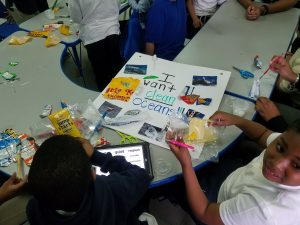 The Adventures of Gary and Harry by Lisa Matsumoto
The Adventures of Gary and Harry by Lisa Matsumoto
- This book is great to advocate for a clean planet, specifically clean oceans. In this story, Gary and Harry are sea turtles and best friends, who are looking to have lunch one day. Instead of eating a jellyfish, Gary finds himself choking on a plastic bag, and getting very scared. Harry thankfully went to sea turtle CPR class and saves Gary, but this is the story that I introduced the Great Pacific Garbage Island and discussed that our actions and what we eat/drink/toss away impact animals like the sea turtles and fish that live in our oceans.
- This was also the story I read right after I participated in the People’s Climate March, so we decided to create our own signs (out of ones I picked up at the march!) that we would use to advocate for our animal friends like Gary and Harry.
Aani and the Tree Huggers by Jeanine Atkins
- This book is based on true stories from the 1970s where Indian villagers would embrace trees to prevent contractors from cutting them down. Also known as the Chipko movement, this story spoke to my students and I because saving trees by hugging them not only seemed wonderful, but also spoke to the belief that resisting destruction by choosing love and standing up for what you believe in will help save the world.
- Any book that I ever read to my students is very dramatized – I use different voices for characters, as well as my personal narrator voice. Kids love stories, and flair – and reading it to them with different voices and facial expressions increased their interest and engagement during the read aloud.
- This is another book I needed to paraphrase, because the text was long. I did not break this story down; instead, I turned the pages and dramatized the story through picture descriptions. An example of a Message Time lesson is below.
Objective: You will learn the vocabulary word “Namaste” and review/practice identifying quotation marks.
Materials:
- SMARTboard
- ‘Namaste’ vocabulary card
- Aani and the Tree Huggers book
Procedure: Teacher will read to students “Aani and the Tree Huggers” – she will paraphrase the story and length to increase student engagement.
“Our story inspired me to think about things that we have read in this book and The Lorax. Each of us has ideas, thoughts and stories in our heads. When we write them down, other people can read them and know what we are thinking and feeling. Today, I’ll be writing ideas and thoughts that are in my head so you can read them with me and know what I am thinking and feeling and wondering. I want you to try and predict what my picture will be, and what words you think I will write in our message. Now, we know what the Lorax says – “Stop! I speak for the trees” Today, my message is going to be about our new friend, Aani, and what she says to people who want to cut down trees.”
Message: Aani says, “Namaste, I speak for the trees.”
Pablo’s Tree by Pat Mora
- This book follows a Latino boy who is celebrating his birthday with his famiglia. Pablo spends the day after every birthday with his grandfather, who decorates a tree for Pablo’s birthday every year. This book was used to practice my students describing and identifying things in pictures, verbally, pointing, or using a device. It also made for some fun art projects, creating and decorating their own trees using pieces of my old Christmas tree!
Wangari’s Trees of Peace by Jeanette Winter
- This book is based on the life of Wangari Maathai, the founder of the “Green Belt Movement” in Kenya. In our class, we concentrated on Wangari’s feelings in the beginning, middle, and end of the story. In the beginning, she was happy because there were lots of trees. In the middle, she was sad because all the trees had been chopped down. At the end of the story, she was happy because her and other friends replanted trees and brought the forest back to Kenya. Wangari says, “Jambo, we need to plant more trees.” We also were able to plant seeds in eggshell cartons and take care of the baby plants, as well as a jade plant that I brought in from home.
Uno’s Garden by Graeme Base
- This book is beautiful, colorful, and really brings the message home of how we as humans really have the largest impact on the planet. This is a great book to ‘wrap up’ and reflect on all that we have done and can do to help the planet. Through this unit, we have done lessons about saving animals, such as the pangolin and the rhinos, and my students have signed petitions to help advocate for wildlife protection. This story all about how much of an impact humans have on a habitat, and what actions should and shouldn’t be done while developing a community. This is where my students will embrace the mentality of being part of the solution, and advocating for animals.
The Earth and I by Frank Asch
- In this book, I have the students look inwards and reflect on their actions impacting the planet, and how they feel about being part of the Earth. This text is simple, and I can ask questions about pictures in the story, as well as feeling words. The lesson below is a small group lesson done with my ‘high’ group of students. This group includes two verbal students who can sight read (with no comprehension), one communicative student who can identify class vocabulary words, and a nonverbal student who uses an iPad to participate in discussions.
Objective: You will point to pictures, vocabulary words and make a connection to our new book and our environment theme. You will create your own ‘Earth portrait’.
Materials:
- The Earth and I book
- large paper
- visuals and vocabulary words – printed (tree, Earth, Lorax, Namaste, Jambo, speak, plant)
- colored pencils
- scissors
- glue
Procedure: Teacher will read to students “The Earth and I”
“Our story inspired me to think about things that we have read in this book, and all of our Earth books we have read this year. We know what the Lorax says – “Stop! I speak for the trees” and Aani says, “Namaste, I speak for the trees.” and Wangari says “Jambo, we need to plant more trees.” But this story is about you – do you see this little boy? He can be any of you, so today I want to know what you say. How do you speak for the trees? Do you think the boy in the story likes the Earth? Do you like this planet? Why, what do you like about Earth? How do you feel when you see a picture like this? (picture of boy playing – happy page). Now, when I think about the Earth, this is how I feel. (show example + explanation) I want you to make your own version of how you feel about the Earth, and I want you to draw yourself in the middle. I want you to write about your connection to the Earth using this large sheet of paper and our magical colored pencils.”
- JPN – will draw himself, write his first name (all letters), and draw and/or cut and paste vocabulary words and pictures to his image.
- JS – will write the letter ‘J’ and draw/trace a circle/face, and cut and paste vocabulary words and pictures to his image. He will use device to identify words/phrases.
- ZD – will draw himself, the Earth, write his full name, write at least 1 or more vocabulary word, draw/cut and paste pictures to his image.
- AL – will draw himself, the Earth, write his full name, write at least 1 or more vocabulary word, draw/cut and paste pictures to his image. (prompt to write on the lines/small letters)


